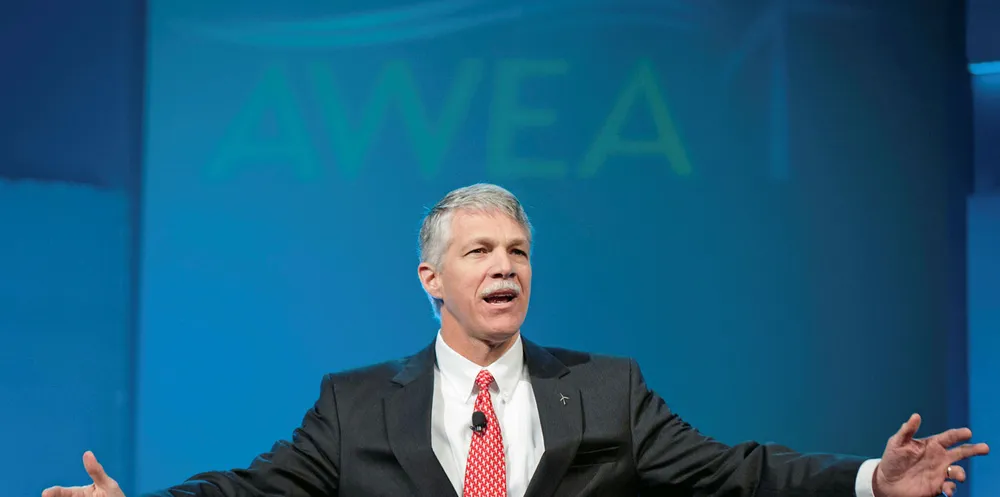US wind industry turns to Trump to soften 'significant' blow from Covid
Federal assistance sought to offset impact of coronavirus, as well as future support from economic stimulus bill for electrical grid infrastructure, says AWEA boss

The US wind industry is seeking further federal government assistance to overcome “significant” Covid-19 impacts, support the emerging offshore sector and secure funding in any future economic stimulus bill for electrical grid infrastructure upgrades, the CEO of industry body the American Wind Energy Association (AWEA) has said.
Citing tightness in supply of tax equity for wind project investment, Tom Kiernan said the industry wants production tax credits (PTC) refundable in cash, a move it says will more effectively and quickly monetise them.
“To obtain direct payment or something similar,” Kiernan told the opening session of its virtual Cleanpower conference – an annual event until this year known as AWEA Windpower. Such refundability would not increase the federal deficit now at its highest levels since World War II, renewables groups contend.
On 1 April, there was a record 24.7GW of capacity under construction nationwide and an additional 19.7GW in advanced development, according to AWEA.
Kiernan said after worker safety, the industry’s next priority with coronavirus has been to “keep that momentum with the pipeline going. Get these projects in the pipeline up and running and on the grid”.
Knock-on and potential longer-term impacts from Covid-19 have caused a pinch point with tax equity availability as some smaller bank players step back from the renewables market due to shrinking tax exposure.
In some cases, it is because of uncertainties with their credit card and loan businesses which have suffered steep losses as millions of unemployed Americans and some businesses forced to close by states to slow spread of the pandemic stopped paying their bills.
In other cases, the clouded US economic outlook has given some project investors and lenders pause as they assess perceived increases in counterparty risk for certain off-takers.
Bank of America and JP Morgan, which together control half of the estimated $13.5bn (in 2019) tax equity market, say they still have plenty capital available for wind. Most of the largest project developers have already arranged tax equity financing, a key reason that installations this year should exceed or come close to the 13.1GW industry record in 2012, analysts said.
AWEA in March estimated the pandemic had put 25GW in project investments worth $35bn at risk, plus 35,000 of 120,000 industry jobs. It has not updated those numbers since it scored a major lobbying win last week.
The Department of Treasury gave developers who started construction of projects in 2016 or 2017 an extra year to complete and qualify them for federal production tax credits (PTCs) at full or 80% value, in recognition of delays from Covid-19 disruptions at state regulatory bodies and to supply chains and workforces.
“We very much want to thank them for that,” said Kiernan. The PTC, worth $24/MWh over 10 years at 100% value, is the main federal subsidy for the sector. Last December, Congress renewed the incentive at 60% value for projects that begin 2020 construction and complete it within four years.
Turning to offshore wind, Kiernan said the industry needs to do more in its lobbying efforts to secure support for a sector that has shown enormous growth potential along the Atlantic coast in the last several years.
He noted Treasury’s one-year extension to complete 2016-17 projects was unhelpful for offshore wind that faces “very unique and significant challenges.” Among them are longer authorization process and construction timelines, the absence of a meaningful domestic supply chain and coastal grid shortcomings.
Kiernan did not detail what federal assistance AWEA and offshore wind advocates want from Congress and President Donald Trump’s administration, although previous efforts have focused on a multi-year investment tax credit (ITC) applicable for 20% to 30% of a project’s capital expenditure.
Earlier this year, AWEA estimated that the US offshore wind industry will invest between $28bn and $57bn this decade depending on installation levels and supply chain growth, with project development, construction and operations supporting 45,000 to 83,000 jobs by 2030.
Kiernan also said AWEA will lobby Congress to provide funding for grid or transmission enhancements in any next potential Covid-19 economic stimulus legislation. Grid constraints could slow corporate renewables procurement and inhibit development of world-class wind resource in the country’s interior and off the east coast.
(Copyright)